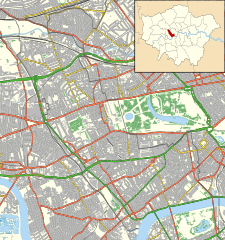Church of Our Most Holy Redeemer and St Thomas More, Chelsea
| Church of Our Most Holy Redeemer and St Thomas More | |
|---|---|

View from corner of Upper Cheyne Row and Cheyne Row
|
|
| Coordinates: 51°29′04″N 0°10′12″W / 51.4845°N 0.1699°W | |
| OS grid reference | TQ2717177759 |
| Location | Chelsea, London |
| Country | United Kingdom |
| Denomination | Roman Catholic |
| Website | HolyRedeemerChelsea.co.uk |
| History | |
| Dedication |
Christ the Redeemer Thomas More |
| Consecrated | 21 June 1905 |
| Architecture | |
| Status | Parish church |
| Functional status | Active |
| Heritage designation | Grade II listed |
| Designated | 7 November 1984 |
| Architect(s) | Edward Goldie |
| Style | Renaissance Revival |
| Groundbreaking | 7 June 1894 |
| Completed | 23 October 1895 |
| Administration | |
| Deanery | Kensington and Chelsea |
| Archdiocese | Westminster |
| Province | Westminster |
The Church of Our Most Holy Redeemer and St Thomas More, also referred to as Holy Redeemer Church, is a Roman Catholic Parish church in Chelsea, London. it was built in the 19th century and opened on 23 October 1895. It was designed by Edward Goldie. It is situated on the corner of Upper Cheyne Row and Cheyne Row, next to Carlyle's House in the Royal Borough of Kensington and Chelsea. It is listed Grade II on the National Heritage List for England.
In the early 1890s, Cardinal Herbert Vaughan requested Canon Cornelius James Keens to go to Chelsea and create a mission to serve the local Catholic population. In 1892 Canon Keens obtained permission from the Archdiocese of Westminster to build a church in the area. Originally, it was to be called the Church of the Most Holy Redeemer. The foundation stone was laid on 7 June 1894 and the church was opened on 23 October 1895. The church was consecrated on 21 June 1905 by Cardinal Francis Bourne.
The dedication of the church was changed in 1935 after Thomas More was canonised. It became the Church of the Most Holy Redeemer and St Thomas More.
In September 1940, during World War Two, the church was damaging by a bomb. It killed nineteen people. The west wall and organ were destroyed. After the war, the church was repaired.
In 1962, the restoration work was undertaken in the church. From 1970 to 1972, the church was reordered. The floor of the chancel was relaid, so that the altar could be brought towards the congregation and a marble ambo was installed. In 1980 a new font was also installed to match the ambo.
...
Wikipedia

